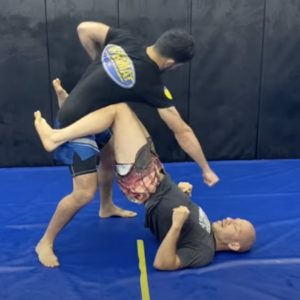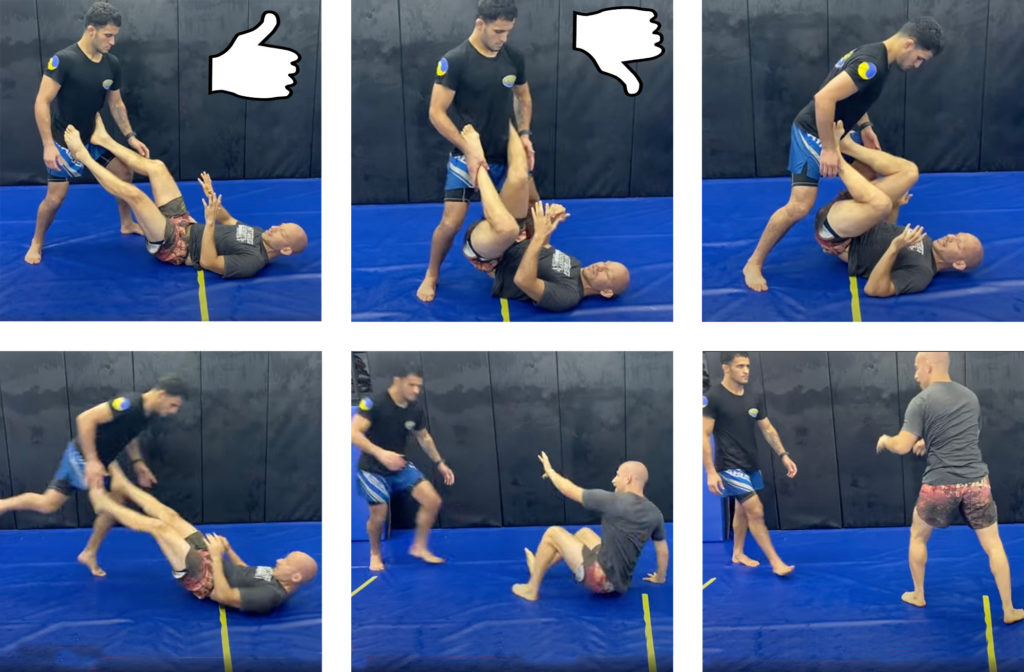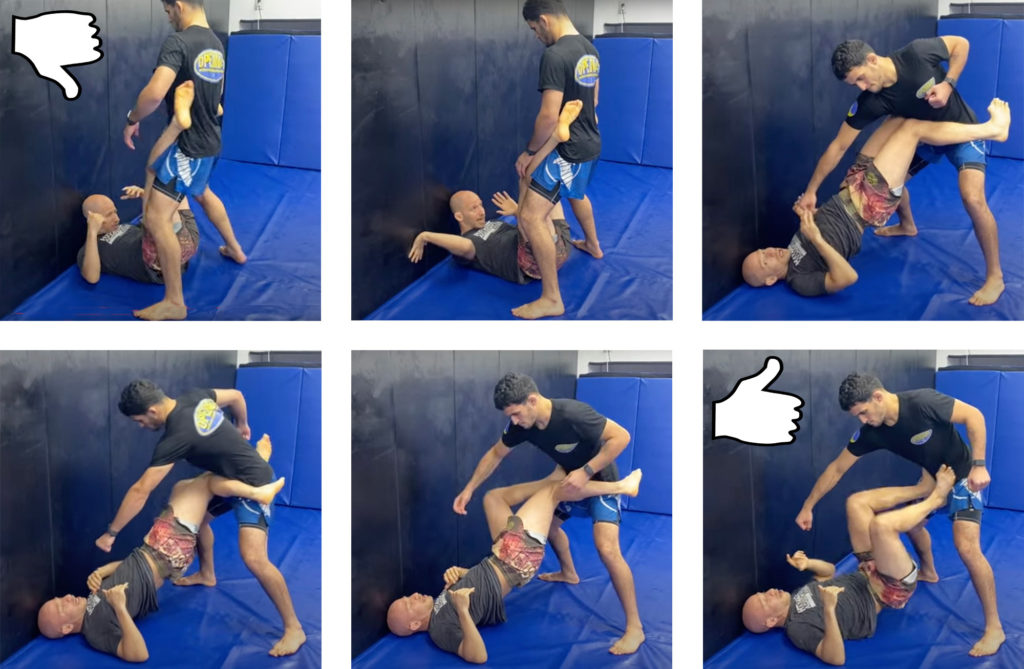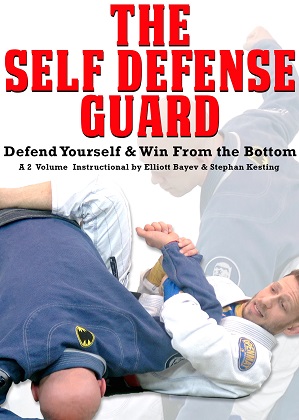One of the central concepts of using the guard for self defense is to either keep your opponent very close or very far away.
When he’s very close it’s hard for him to generate enough power for a knockout shot. And if he’s very far away then his punches simply can’t reach you.
It’s the middle ground that gets you killed. This is where punches reach their full KO power, where headbutts can split your face open, and where your opponent can pummel you with elbows.
It’s easy to say ‘stay out of the middle ground’, but implementing this in the chaos of a real fight is slightly more difficult.
This is exemplified by classless Conor McGregor (my least favorite UFC fighter by the way) getting pounded in the bottom position during his fights against both Khabib Nurmagomedov and Dustin Poirier.
Here’s my friend Elliott Bayev (author of The Self Defense Guard) with a video breaking down the concepts of how to stay safe on the bottom using Conor’s fights as teachable examples. He called it “What Conor McGregor Should Have Done Against Dustin Poirier”.
(I actually think learning good ground and pound defense is the second thing Conor should have done; the first was to stop being a complete asshole, but that’s just me!)
Here’s the video, and regardless of whether you like Conor or not it’s got some extremely actionable tips for you!
Conor McGregor rose to prominence as one of the biggest names in the UFC thanks in part to his cockiness but also to his spectacular striking ability and many impressive wins over MMA greats including Donald Cerrone, Jose Aldo, and others
Conor actually has decent groundfighting skills, despite only having one submission win. That said, in his recent rematch with Dustin Poirier, a major weakness was exposed – one that was present in his fight with Khabib Nurmagomedov – defending against punches from the bottom.
To be fair, it’s easy to play armchair quarterback and critique the technique of someone facing one of the best in the world, but he still seemed to be missing a core BJJ fundamental – something we see all too often from fighters of all levels: effective counters to a ground and pound offense.
Let’s review the major tactics covered in the video above…
Ground and Pound Defense 1: Close the Distance

The first thing we should do to prevent punches is to tie the opponent up. From our guard, we pull them in with our legs and wrap up one or both arms, controlling their posture, taking away the thing they require in order to punch us – distance.
From here we can set up sweeps and submissions, but most importantly, we cannot be hit. We saw Connor try this against both Poirier and Khabib, but, as is sometimes the case with any technique used against high level opponents, it failed.
It’s the middle range in ground and pound where you’re going to get your bell rung, so if you find yourself here it’s time to move!
Above Elliott starts in the danger zone; he has his opponent in the closed guard but the distance is all wrong. His opponent can land powerful punches at will.
To close the distance Elliott covers his face and temples with his forearms (a position known as the helmet). He also pulls his opponent towards him with his legs while keeping his ankles locked around the his torso.
Once close he uses the overhook to control an arm and uses the other arm in a variety of ways to control posture and stop his opponent from sitting back up.
There are lots of sweeps and submissions from this overhook and head control position from closed guard, but most importantly thing is that you’re relatively safe here.
Survive first and win later is the name of the game when you’re on the bottom getting pounded on!
Ground and Pound Defense 2: Knees on Chest

If we cannot pull the opponent in, we must keep them away. Our arms will not be sufficient to block strikes or control distance and so we must get our legs as a barrier.
Many fighters feel they have some safety from their guards and so try to keep their legs locked, but this only keeps the opponent in the range necessary to strike. Instead of holding onto the guard, we have to unlock our legs and bring our knees in between us and the opponent, using them as a shield.
Many try this, but are missing the key detail that makes it work – lifting the hips. With the hips on the ground, the opponent can still rain down punches even if the knees are on their chest. With the hips lifted the line from our shoulders to our knees straightens out and becomes far too great for an opponent to make contact.
From here, first and foremost, we are safe. We can look to pull them back in if they overcommit to coming forward, get feet on their hips and kick them far enough away so we can stand up safely, or look to attack their exposed legs.
Look at the 3 pictures above and let’s imagine that you are on the bottom. Furthermore let’s say that you just can’t pull your opponent forward. Maybe he’s basing on your body with his arm, or maybe he’s got incredible spinal erector strength.
You’ve got to change the situation immediately. You DON’T want to let him stay in the perfect range for caving your face in with his fists!
What you’re going to do here is open your guard and bring your knees together in front of his chest. But that’s only part 1 because he can still reach out and touch you.
Now you also need to bridge your hips up. This puts your knockout zones (chin, temple and neck) out of range.
This is the ‘double knee shield position’ and it works! Try it and see.
By putting your knees in his chest and bridging you’ve taken a bad situation and made it much better.
This is a good solution to a very pressing problem, but it’s only a temporary fix. You can’t hang out here forever because you are vulnerable to groin strikes and leglocks if your opponent is so inclined.
That’s why once you’ve protected your head here you want to kick your opponent away, work towards getting back to your feet, or – if you’re very confident in your guard – start attacking him from the bottom with sweeps and submissions.

As you can see in the photo above putting your knees together and bridging your hips up works even if your opponent is standing so long as he’s driving in on you.
If he backs off then you can’t use this defense but on the other hand he’s also now out of punching range. Start bicycle kicking and work your way back to your feet!
Ground and Pound Defense 3: Feet on the Hips

If your opponent is standing then having your feet on his hips is an excellent way to keep him away from you. But like all techniques there’s a right and a wrong range to use this strategy.
If your opponent gets really close, postures up and pushes his hips forward (picture 2) then he’s turned your legs from frames into two giant levers. At this point it’s time to switch back to the knees together position we discussed earlier.
Assuming that you’re at a medium range and have your feet on his hips you can also recoil your legs in a little bit (picture 3) and then push violently forward in a leg press motion which will launch him off the ground and throw him backwards (picture 4).
Now that you’ve got sufficient distance between you and your opponent you can use a technical standup motion to safely get back to your feet.
Conor did get knees in between him and both Poirier and Khabib, and also tried using feet on the hips, but in both cases he had his hips on the ground. This is ineffective, particularly when pressed up against the cage.
Which brings us to our next point…
Ground and Pound Defense 4: Defending Against a Wall or a Cage

Life becomes more complicated if you’re crowded against a wall, cage, or other obstacle
That’s because the other guy can now crowd you against the wall which kinks your neck forward (picture 1). With your spinal posture broken like this it becomes impossible to bridge. At this point neither knees on the chest, nor feet on the hips will be effective.
So don’t stay in this pretzeled position!
Abandon ship by putting one hand on the wall (picture 2) and pivoting so that you can straighten your spine and bridge your knees back into that same defensive position (picture 3).
From here you can continue to improve your position further by moving to a one-sided knee shield (picture 4), getting your other foot on his hip (picture 5), and then resetting in the double feet on hips position.
Once you’ve gotten both feet on his hips don’t stop; time to kick him backwards, make space, and work back towards your feet!

For the more advanced practitioner your have another option from the double knee shield position: spinning to his legs.
Typically to do this you’ll hook one of your arms inside his leg (picture 1), then spin upside down bringing one knee between his legs and your other leg behind his knee or hips (picture 2).
In picture 3 you can see that Elliott has ended up behind his opponent which obviously has a huge tactical advantage. But that’s not the only way things can go; from this basic entanglement you can enter into a variety of leglocks (including heel hooks and kneebars), sweeps, back takes and scrambles.
More Guard Training Specifically for Self Defense
Elliott Bayev and I have collaborated to create an instructional that’s all about surviving and winning a real fight when you find yourself on the bottom.
The emphasis is on using the guard to defend yourself and not get hurt.
And then we cover exactly how to get back to your feet, even if he’s driving all of his weight down into you…
And then we go deep into your offensive options from the bottom including armlocs so he can’t punch or grab you anymore… And chokes to render him helpless… And sweeps so you end up on in a dominant position on top.
Make sure to check out Elliott’s The Self Defense Guard instructional, available in streaming and DVD formats here on Self Defense Tutorials.
More Elliott Bayev
Elliott is an experienced black belt based in Toronto, Ontario who is at the cutting edge of jiu-jitsu instruction.
Check out his remote learning website at BJJ101.tv, his school at Openmat.ca, and follow him on Instagram at @elliottbayev.
